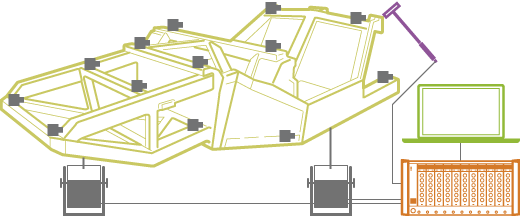
Classical modal analysis
Classical modal analysis is used for modal parameter identification of structures under controlled boundary and environmental conditions using hammer or shaker excitation.
Ask an ExpertIn Classical Modal Analysis, a model of a structure’s dynamic properties consisting of the modal parameters (natural frequencies, damping ratios and mode shapes) is obtained by exciting the structure with measurable forces and determining the response/excitation ratio.
Classical Modal Analysis ranges from simple mobility tests with a roving impact hammer and a fixed accelerometer to multi-shaker testing of large structures using hundreds of accelerometers. It is used in a vast range of tests including design verification and optimization, certification testing, troubleshooting and benchmarking.
System suggestion
Our classical modal analysis solutions guide you through the complete set-up, measurement and analysis in simple and intuitive steps, and provide you with accurate and reliable results even in the most demanding situations, with a targeted set of best-in-class modal parameter estimators and validation tools.
Our solutions cover the entire measurement and analysis chain including accelerometers and force transducers, impact hammers, modal exciter systems, LAN-XI data acquisition hardware and BK Connect® software for pre-test analysis, measurement, analysis and Finite Element model correlation. Our solutions are also expandable so they can grow with your requirements.
Video: Brüel & Kjær Stepped Sine
Recorded webinar: Modal Analysis using Hammer or Shaker Excitation

当社ニュースレターを購読すると音とバイブレーションの世界からの最新情報を取得できます。









